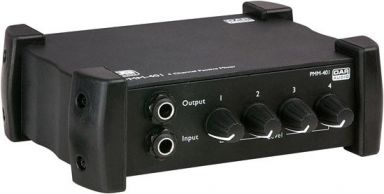Microphone preamplifiers
Microphone preamplifier
Want to experiment with timbre or take home studio activities to the next level? Then you should get an external mic preamp. Where the audio interface reaches its limits, musicians and sound engineers turn to professional mic preamps.
The requirements for mic preamps are highly individual. On the one hand, the preamp must fit the equipment and circuitry used. On the other hand, the sound simply has to be right. And, as we all know, that's a matter of debate, just like taste.
Microphone preamplifier: hold the level
A microphone preamplifier is used to bring the output signal of the microphone up to the standard working level for the studio. While most instruments and loud voices require little amplification, the line level of microphones is usually 30 to 60 dB above the output signal.
If you've only ever worked with an audio interface, you're familiar with the automatic amplification provided by built-in preamps. But maybe your current interface is now reaching its limits and you are faced with the choice: buy a more expensive audio interface or an external microphone preamplifier after all? If you weigh a few factors, you'll find that buying an external mic preamp is often worth it.
Advantages of microphone preamplifiers
Less noise
An external microphone preamp can audibly reduce noise, even when recording quiet audio sources such as through dynamic microphones. Good external mic preamps operate with substantially reduced inherent noise, which significantly minimizes the overall noise floor.
Better sound quality and more gain
Since microphones require a comparatively large amount of amplification, simple power amplifiers or built-in preamplifiers reach their limits at around 50 dB, so that the sound result appears washed out - it loses power and clarity.
High-quality microphone preamplifiers with their more complex circuitry ensure full sound transparency, even at high gain. Especially with dynamic microphones, this factor plays a decisive role. Ribbon or moving-coil microphones sometimes need a gain of 70 dB.
Sound with character
One of the most important reasons to reach for an external microphone preamp is the changed sound texture. Anyone looking for a special timbre will usually only find it thanks to an external mic preamp. The crystal-clear and very transparent sound that the built-in preamps in audio interfaces can conjure up is often not at all desired for vintage styles. It should sound a bit "dirty" and "handmade". With the right mic preamp, these sound dreams finally come true. The special design of a mic preamp has an influence on the sound characteristics. For example, the sound can be as follows:
• soft or hard,
• thin or opulent,
• neutral or colored,
• transparent or coarse
Sound is very subjective. It can only be measured inadequately. Instead, it has to please and fit. That's why it's important to try out mic preamps! Even a change in microphone placement can have a significant effect on the sound. Therefore, test the mic preamp in advance with microphones and instruments you know in combination. That way you can decide what sounds better.
Larger range of functions
Automatic preamplifiers in audio interfaces usually offer only the most important basic functions. With external preamps, you can achieve this, among other things:
• Input attenuation (pad) against unwanted oscillation of the loudspeaker
• Low cut or high pass to suppress low-frequency noise such as footsteps or rumble
• Phase inversion, i.e. the deliberate reversal of the polarity of sound signals in order to correct them or eliminate them altogether
As many channels as needed
When purchasing a microphone preamplifier, there is also a very pragmatic decision to be made: How many channels should it have? Single-channel preamps are an inexpensive option. These are recommended if you only work with your voice. The situation is different when using instruments: If you also use an acoustic guitar, another instrument microphone is already necessary and thus at least a second channel. For recording drums, an eight-channel preamp is the right choice. Keep in mind that each additional channel always adds to the price. "The more channels, the better!" is unfortunately not the right motto for microphone preamps. Rather, you should know exactly what you intend to do with your preamp and what it needs to do. A good starting point is the sources of error and frustration that result from working with your previously used audio interface: What's good? What do you want to improve?
• For example, is the noise disturbing?
• Would you like to use more customers?
• Are you looking for more suitable functions for sound manipulation?
• Is the timbre not warm enough?
Conclusion: When is a microphone preamplifier important?
The use of external mic preamps has proven itself in practice in these cases, among others:
• You want to go a step further in your home studio, because you are reaching your limits with built-in preamps in audio interfaces
• As a sound engineer, you want to create more sound variety or a specific sound character
• You are a musician and also play quiet sounds. You are annoyed by a noticeable background noise or distortions.
• You work with ribbon or other dynamic mics instead of condenser mics
• You need more or a more suitable number of channels
For all questions about microphones and event technology: LTT
In the LTT online store you will find a wide selection of external microphone preamps to take your audio to the next level. Do you need advice or help making a decision? Then contact our audio technology experts right away. We will be happy to help you!






















 Express delivery possible
Express delivery possible

